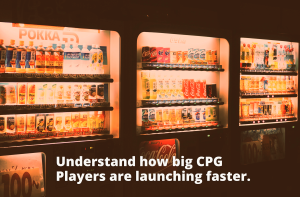Why have entrepreneurs been winning this battle?
What was the latest successful new brand that caught your attention in the consumer sector?
- SuperCoffee, the coffee-based drink that made R$160 million last year?
- Pura Vida, the supplement brand acquired by Nestlé this year?
- Bold, Trento, Flormel, and many others trying to reinvent the snack market?
Good chances you might have thought of some of these or similar ones.
The most intriguing question is: what do they have in common?
All were launched by entrepreneurs, focused on niches in sectors dominated by large industries, which despite their capital and experience in the sector, couldn’t capture these opportunities.
The objective of this article is to dissect this phenomenon and provide tips that can help entrepreneurs strengthen their brands and industry executives revitalize their product lines.
Before you invest 10 minutes of your time in this article, a brief context: I write about this subject because I’ve faced this challenge firsthand and believe it to be the biggest change in the consumer goods market in decades.
I worked for 20 years as a marketing executive in large companies and discovered how difficult it is for giants to understand and adapt to this dynamic.
I set up an innovation area based on agile methodologies in a large multinational and realized that it’s possible to be much more agile, efficient, and creative by operating with a startup mentality.
But the cultural challenges of accelerating a giant prevent replicating the model to its full potential.
I have mentored dozens of consumer startups to understand how founders operate, what their main challenges are, and accumulating insights that aren’t currently available in business literature in a simple and applicable way.
This context led me to co-found Emerge Ventures. We invest in consumer brand, helping entrepreneurs unlock the business potential through capital, management, and connections.
With a privileged and comprehensive view of the subject, the goal of this article is to share some of these insights with a broader audience.
More than an exhaustive list, these tips serve as points of reflection that can shorten this journey and avoid predictable mistakes.
1. Sail off the radar
The first major choice for any founder is where to play: which category, what value proposition, for which customer, through which channel.
A structural advantage of new brands is their closeness to consumers to find a space that, initially, might be too small to pique the interest of the big industry.
In this process, nothing is more important than understanding consumer behavior almost obsessively. How they consume, why they consume, with whom they consume, what alternatives, etc.
Nothing replaces direct contact with the consumer in this phase. Products are born from the founder’s intuition, emerging brands are born from active listening to their loyal consumers.
This window of opportunity sailing off the radar is key to designing the value proposition and experimenting with different hypotheses until finding a small base of loyal consumers that will be crucial in the future scaling process.
2. Differentiation is more important than salience
One of the central concepts in traditional consumer goods marketing is salience: how easily a brand comes to mind in a purchasing situation.
The purchasing process for a consumer brand is low involvement, and most of the time, there are only a few seconds to decide, whether at the point of sale or on a marketplace.
In this context, the traditional model focuses on high-frequency communication and massive distribution, but it’s a very expensive process and becoming more inefficient as media costs rise and audiences decrease.
For a new brand, it’s much more effective to be different. Investing time in the initial phase of interaction with the consumer (sailing off the radar) to test and validate a differentiated value proposition that addresses unmet needs in a niche.
Offering something different is what allows you to stand out in this competitive landscape and, more importantly, activate word-of-mouth recommendation within the niche, significantly increasing the chances of experimentation.
But this path has a challenge: balancing differentiation with relevance. Being different is easy; the hard part is doing it while maintaining relevance for a small group of consumers that justifies the existence of a minimally healthy business in terms of margins.
3. Find a key message (yes, only one)
Found a relevant differentiator? Congratulations, but having a complex differentiator that only works if you explain your product in a demo with the consumer is of no use.
Translating the differentiator in a simple and straightforward manner across all consumer touchpoints is the “hack” that increases your chances of being noticed at the point of purchase and makes it easier for early fans to spread the message within their group.
Most have probably seen new brands, especially in healthy products, with an endless list of benefits on the packaging: gluten-free, no artificial colors, no added sugar… An endless list of benefits only leaves the consumer unsure about what the product is and what it solves.
A good example is the case of the ice cream brand Halo Top. The original proposition of being an ice cream with a better nutritional profile stumbled until they discovered through their most loyal users that the main reason for purchase was the surprising fact that it had around 300 calories per pint compared to over 1000 in traditional brands.
The business took off only when they decided to dramatize this key message on the packaging and put all other messages in the background.
4. Memorability matters more than capital
Memorable: unforgettable, worth remembering.
You can’t compete with the advertising and distribution machine of established brands. The alternative route is to focus on creativity to increase your chances of being remembered.
One of the most emblematic recent cases to illustrate the concept is that of Liquid Death, an American water brand with a visually striking, if somewhat unusual, aesthetic inspired by heavy metal.
This polarizing aesthetic is undeniable, and in a sea of transparent blue bottles on a shelf, it’s nearly impossible not to notice this exotic item.
What might seem like just shock marketing at first glance is, in fact, the execution of a powerful insight: a water brand behaving like an energy drink brand.
You might not like it, but it’s hard to ignore. And with over $100 million in revenue last year, it seems to be attracting enough people in a historically difficult-to-stand-out category.
5. Authenticity is key and hinders replication
Trying to differentiate yourself solely based on the product is an invitation to be copied. And if you get on the radar of a big brand with dozens of people in research and development, the story tends to end poorly.
Now, deeply understanding an initial consumer base and establishing a genuine relationship with them helps you build something that’s harder to copy: authenticity.
Transparency in communication and, especially, speed in making tough choices that resonate with your initial customers go against the operational model of mass marketing.
6. Build a demand generation thesis
Demand generation is a complex term for a simple concept: how to stimulate your potential consumers to get to know and buy your brand.
Community marketing, affiliates, influencers, search, ads, PR, sampling, events… The list of demand generation tactics to make your brand known and generate trial is practically endless.
However, it’s easy to get lost in the tactics and divide the limited resources attacking many fronts.
The best brands combine structured thinking by raising hypotheses about how the consumer can discover their brand, the flexibility to test experiments quickly and at low cost, and the creativity of execution and investment concentrated in validated channels.
This slightly more scientific mindset focused on hypotheses, experiments, and validation that lead
to repeat purchases is very useful for finding more efficient and effective demand generation channels.
7. It’s the 4Ps, not just the product
Agility and experimentation in the marketing mix are some of the most underutilized assets for founders of new brands.
The natural bias is to look at the product. Most origin stories of new brands begin with the founder’s obsession to fill a gap in the market, and the natural behavior is to keep thinking primarily about the product.
However, something impossible for large brands to replicate is the speed of testing different elements of the marketing mix, simply because the operational complexity of large companies doesn’t allow a battleship to change course quickly.
Shifting the focus from the product to the consumer is the best way to generate hypotheses to test different elements of the marketing mix. There’s probably no better time invested in the initial stages of new brand development.
8. Concentrated distribution is key
The traditional model for a large company’s launch is to disproportionately invest in communication and massive distribution.
I’ve mentioned several times that this model doesn’t work for new brands.
The relentless pursuit of opening new doors has two structural problems: the lack of resources to build a sales team, create inventory and working capital, and the low likelihood that a relatively unknown new brand will work in multiple markets simultaneously.
Concentrating resources in selective distribution (whether channel, geography, or even brand) in places where your consumer is allows you to build brand awareness, test demand generation elements, and measure performance in order to learn before expanding.
An old but relevant example was the entry of premium ice cream brand Häagen-Dazs in Brazil, which spent a considerable time prominently present in Blockbuster to create an association with a relevant consumption occasion for the category and avoid price competition in supermarkets before consumers understood the brand proposition.
Being a big fish in a small pond is the path to start.
9. Learning speed is your biggest advantage
The most traditional analogy to reflect the battle between established brands and emerging brands is the fight between David and Goliath.
Malcolm Gladwell wrote an entire book on the subject (recommended!), explaining that the difference in strengths ends up stimulating innovation (trying something different when facing a giant is crucial) and resilience (a natural filter for those crazy enough to take on this fight).
I bring a third element: beyond innovation and resilience, agility is the third advantage of small players facing giants.
Speed to learn and quickly test hypotheses is perhaps the only thing that can’t be replicated by the big players.
The insight is obvious, the challenge is execution.
Investing time in learning and validating hypotheses with the consumer might seem like a luxury for entrepreneurs working long hours, trapped in operational activities, and facing constant cash pressure.
Solving this dilemma says a lot about the capacity of founders of emerging brands. And those who can allocate time to it have a disproportionate advantage.
10. Focus, focus, focus.
The last lesson is valuable not only for the process of building new brands but, above all, for managing new businesses.
The vast majority of entrepreneurs believe in the “spaghetti” strategy, throwing a bunch of ideas at the wall to see what sticks.
It might work, but it’s more luck than judgment.
Deciding on a few priorities to focus energy on that will have a disproportionate impact on the brand’s and business’s performance exponentially increases your chances of success.
Focus on understanding your consumer and finding a key differentiator and message (rather than an endless list of claims).
Focus on finding your flagship product and trying to scale it (before launching a bunch of new products).
Focus on validating the demand generation model and doubling down when you find the path (instead of dividing limited resources among many tactics).
Focus on finding the most relevant sales channel and being a big fish in a small pond (instead of celebrating the number of doors you have, even if the turnover is minimal).
In short, focus on being conscious of where you’re allocating your time in activities with the highest leverage potential, not just on what’s urgent.
I hope these reflections stimulate conversations between you and your teams in this incredible challenge of creating and scaling emerging brands.
For more tips on the subject, visit the Emerge Ventures blog.





